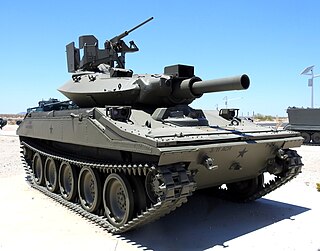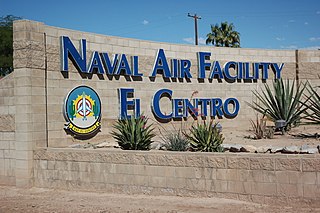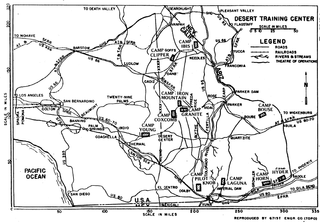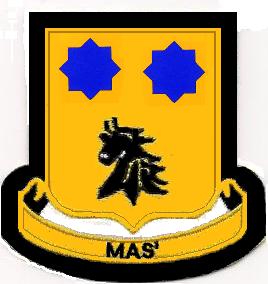
The M551 "Sheridan" AR/AAV was a light tank developed by the United States and named after General Philip Sheridan, of American Civil War fame. It was designed to be landed by parachute and to swim across rivers. It was armed with the technically advanced but troublesome M81/M81 Modified/M81E1 152 mm gun/launcher, which fired both conventional ammunition and the MGM-51 Shillelagh guided anti-tank missile.

The 11th Armored Cavalry Regiment is a unit of the United States Army garrisoned at the Fort Irwin National Training Center in California. The regiment has served in the Philippine–American War, the Pancho Villa Expedition, World War II, the Vietnam War, Gulf War and Iraq War. The 11th ACR serves as the opposing force (OPFOR) for the Army and Marine task forces, and foreign military forces that train at Fort Irwin.

Fort Huachuca is a United States Army installation, established on 3 March 1877 as Camp Huachuca. The garrison is now under the command of the United States Army Installation Management Command. It is in Cochise County in southeast Arizona, approximately 15 miles (24 km) north of the border with Mexico and at the northern end of the Huachuca Mountains, adjacent to the town of Sierra Vista. From 1913 to 1933, the fort was the base for the "Buffalo Soldiers" of the 10th Cavalry Regiment. During the build-up of World War II, the fort had quarters for more than 25,000 male soldiers and hundreds of WACs. In the 2010 census, Fort Huachuca had a population of about 6,500 active duty soldiers, 7,400 military family members, and 5,000 civilian employees. Fort Huachuca has over 18,000 people on post during weekday work hours.

California's involvement in the American Civil War included sending gold east to support the war effort, recruiting volunteer combat units to replace regular U.S. Army units sent east, in the area west of the Rocky Mountains, maintaining and building numerous camps and fortifications, suppressing secessionist activity and securing the New Mexico Territory against the Confederacy. The State of California did not send its units east, but many citizens traveled east and joined the Union Army there, some of whom became famous.

Yuma Proving Ground (YPG) is a United States Army series of environmentally specific test centers with its Yuma Test Center (YTC) being one of the largest military installations in the world. It is subordinate to the U.S. Army Test and Evaluation Command.

The General George S. Patton Memorial Museum, in Chiriaco Summit, California, is a museum erected in tribute to General George S. Patton on the site of the entrance of Camp Young, part of the Desert Training Center of World War II.

Naval Air Facility El Centro or NAF El Centro is a United States Navy Naval Air Facility located approximately six miles (10 km) northwest of El Centro, in Imperial County, California. NAF El Centro is under the jurisdiction of Navy Region Southwest and serves both as temporary homeport to military units conducting air-to-air and bombing training, and as the winter training home of the Blue Angels aerobatics display team.
A proving ground (US) is an installation or reservation in which technology such as weapons, military tactics and automobile prototypes are experimented with or tested. Proving grounds can be operated by government bodies or civilian industries. They are distinct from military training areas which are run by the military and intended for the routine training and exercising of troops across the terrain.

Portée describes the practice of carrying an artillery piece on a truck which can be fired from the vehicle or quickly dismounted and fired from the ground. The term is most often used to describe anti-tank equipments used by the British, Commonwealth and imperial forces in the Western Desert Campaign of the Second World War. Modern terms for mounting weapons on vehicles are technical or gun truck.

Camp Roberts is a California National Guard post in central California, located on both sides of the Salinas River in Monterey and San Luis Obispo counties, now run by the California Army National Guard. It was opened in 1941 and is named after Corporal Harold W. Roberts, a World War I Medal of Honor recipient. Nearby communities include San Miguel, Heritage Ranch, Oak Shores, and Bradley, all unincorporated. The nearest incorporated city is Paso Robles. Camp Roberts is roughly 25 miles southeast of Fort Hunter Liggett.

Camp Lockett was a United States Army military post located in Campo, California, east of San Diego, and north of the Mexican border. Camp Lockett has historical connections to the Buffalo Soldiers due to the 10th and 28th Cavalry Regiments having been garrisoned there during World War II. It was named in honor of Colonel James R. Lockett who fought in the Spanish–American War, Philippine Insurrection, and the Punitive Expedition. There was an active preservation effort underway with long-term plans of creating the 'Camp Locket Historic District' in the National Register of Historic Places, which ended due to private property concerns. In 2009 it was designated as a California Historical Landmark, and there are plans to create a county park out of the majority of its former area.

The District of Southern California was a 19th-century district of Department of the Pacific, a command of the United States Army.

The Desert Training Center (DTC), also known as California–Arizona Maneuver Area (CAMA), was a World War II training facility established in the Mojave Desert and Sonoran Desert, largely in Southern California and Western Arizona in 1942.

The 28th Cavalry Regiment (Horse) (Colored) was a short-lived African American unit of the United States Army. The 28th Cavalry was the last horse-mounted cavalry regiment formed by the U.S. Army. The regiment was formed as part of the 2nd Cavalry Division in 1943 and inactivated in North Africa in 1944 without seeing combat.

Camp Ibis was one of twelve divisional tent camps of the US Army Desert Training Center (DTC) which was established in early 1942 during World War II, originally to advance desert tank warfare and to train troops for desert combat. The DTC was located in the Mojave Desert and Sonoran Desert, largely in Southern California and Western Arizona. In October 1943, the DTC was redesignated as the California-Arizona Maneuver Area (C-AMA). The headquarters for the Desert Training Center was Camp Young where General Patton's 3rd Armored Division was stationed. Camp Ibis was designated a California Historic Landmark. The site of the Camp Ibis 8 miles (13 km) East of Needles, California off Highway 95, north of Interstate 40 in San Bernardino County, California. The camp was originally named after the Ibis railroad siding in Piute Valley. The camp was located at the west side of the Dead Mountains Wilderness.

The Temporary Detention Camp for Japanese Americans / Pomona Assembly Center is one of the places Japanese Americans were held during World War II. The Pomona Assembly Center was designated a California Historic Landmark on May 13, 1980. The Pomona Assembly Center is located in what is now called the Fairplex in Pomona, California in Los Angeles County. The Pomona Assembly Center was called Los Angeles County Fairgrounds in 1942.

Camp Hyder was a US Army installation in Arizona, functioning as a subcamp of the Desert Training Center in Riverside County, California. The main headquarters for the Desert Training Center was Camp Young, this is where General Patton's 3rd Armored Division was stationed. Camp Hyder is 2 miles (3.2 km) miles south of Hyder, Arizona. The camp was just north of the Gila River. Camp Hyder is 60 miles (97 km) miles east of Yuma, Arizona, near Camp Horn. Camp Hyder was built at the site of an old 1890s military base. Trained at Camp Hyder, in 1943, for six months was the 77th Infantry Division from April 1943 to September 1943. Then the 104th Infantry Division moved in for training. Unlike the other camps, no large tank activity was done. The camp was built by The 369th Engineer Regiment. Camp Hyder had its own rail station at which most troops arrived. The train station at Sentinel, Arizona south of the camp was also used. Over 13,000 troops were trained at Camp Horn and Camp Hyder.

The Camp Laguna was a sub camp of the US Army, Desert Training Center in Riverside County, California. The main headquarters for the Desert Training Center was Camp Young, this is where General Patton's 3rd Armored Division was stationed. Camp Laguna is 16 miles (26 km) miles northeast of Yuma, Arizona, off of U.S. Route 95. Trained at Camp Laguna were the 3rd Armored Divisions the 9th Armored Divisions, the 79th Infantry Divisions, 80th Infantry Divisions and 8th Infantry Division. The camp is named after the nearby town of Laguna, Yuma County, Arizona on the Colorado River. Camp Laguna was first World War II training camp built in the Sonoran Desert of Arizona, it trained thousands of troop for war. Most of the land that was Camp Laguna is now part of the vast Yuma Proving Ground.

The Camp Pilot Knob was a sub camp of the US Army, Desert Training Center in Imperial County, California. The main headquarters for the Desert Training Center was Camp Young, this is where General Patton's 3rd Armored Division was stationed. Camp Pilot Knob was designated a California Historic Landmark (No.985). Camp Pilot Knob is near Felicity, California, in Imperial County, California. Camp Pilot Knob is 2 miles north of the US-Mexico border, just north of the now Interstate 8. The camp is five miles northwest of Yuma, Arizona and 2 miles west of the Colorado river. The camp was built just north of the Felicity train station, which was used to bring the troops and supplies to the camp. The camp is named after a hill south of the camp.

California during World War II was a major contributor to the World War II effort. California's long Pacific Ocean coastline provided the support needed for the Pacific War. California also supported the war in Europe. After the Japanese attack on Pearl Harbor on December 7, 1941, most of California's manufacturing was shifted to the war effort. California became a major ship builder and aircraft manufacturer. Existing military installations were enlarged and many new ones were built. California trained many of the troops before their oversea deployment. Over 800,000 Californians served in the United States Armed Forces. California agriculture, ranches and farms were used to feed the troops around the world. California's long coastline also put the state in fear, as an attack on California seemed likely. California was used for the temporary and permanent internment camps for Japanese Americans. The population grew significantly, largely due to servicemen who were stationed at the new military bases/training facilities and the mass influx of workers from around the U.S. in the growing defense industries. With all the new economy activity, California was lifted out of the Great Depression. Over 500,000 people moved to California from other states to work in the growing economy. California expanded its oil and mineral production to keep up with the war demand.





















